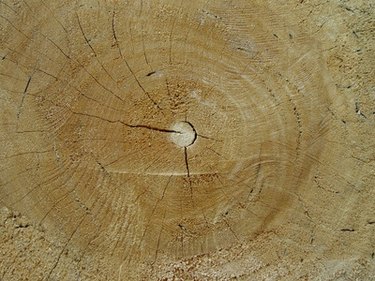
Different types of wood display different reactions to water exposure. Wood will shrink and cracks will develop during dry seasons due to a loss of moisture and expand during hot and humid, summer-type conditions. A heavier, denser wood will do better with water than a light wood. Water also will cause breakdowns, such as rotting and molding on the wood. Once you know the type of wood you have, it's important to treat any wood you're using. Sealing it will ensure that you get the most out of your flooring, deck or furniture.
Mahogany
Video of the Day
Mahogany is a fine-grained, durable wood. Mahogany stands up extremely well to water and is even used to make boats. It resists welling, shrinking and warping very well. Due to its ability to withstand wear and water, as well as its rich, natural reddish-brown color, it is an expensive option.
Video of the Day
Walnut
Walnut is a strong, fine-texture wood. It's easy to work and finishes well, making it a popular choice for furniture, wall paneling and cabinetry. Walnut resists shrinking and warping very well when exposed to water.
Oak
Oak is a flexible, durable wood. It finishes extremely well and is used for furniture, flooring and boat frames. When exposed to moist conditions, oak is very resistant to absorption and warping.
Maple
Maple is a hard wood that is finely textured. Maple is a popular flooring wood and is regularly used in furniture as well. Maple will experience moderate shrinkage when in consistent contact with water and/or humid conditions.
Cherry
Cherry is a close-grained wood that ages well and reddens when exposed to sunlight. Cherry wood is popular in cabinet making and furniture. It resists warping and shrinking extremely well.
Teak
Teak is a hard and durable option used in shipbuilding, doors, flooring and general construction. Teak is a very popular option because it stands up extremely well to moisture exposure and resists warping, cracking, decay and rot.
Pine
Pine is soft wood that works easily for most projects and finishes well. It stands up great to moisture and resists shrinkage, swelling and warping. Pine is commonly used in construction and furniture making.
Spruce
Spruce is a strong yet soft wood; it's used mostly in millwork and aircraft construction. Spruce finishes well and has a great resistance to decay but experiences moderate shrinkage.
Cedar
A soft wood with a reddish color, cedar is easy to work and has a uniform texture. Cedar is used for things such as fence posts, dock planks and furniture. Cedar resists decay, molding and rot extremely well but will experience moderate shrinkage and expansion.